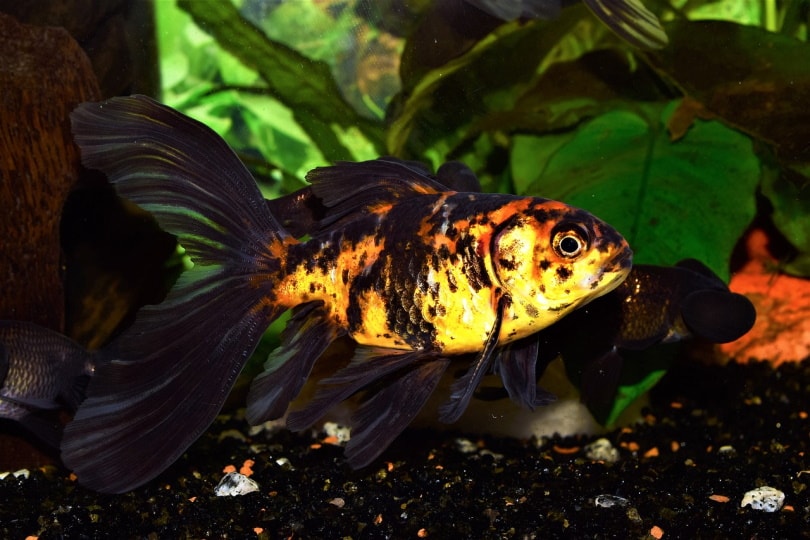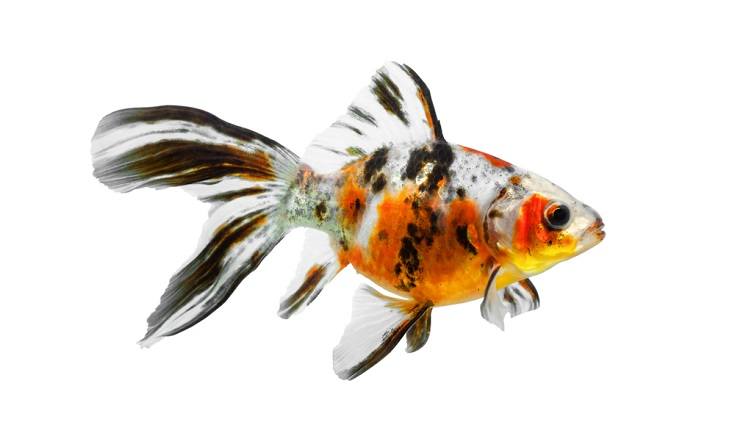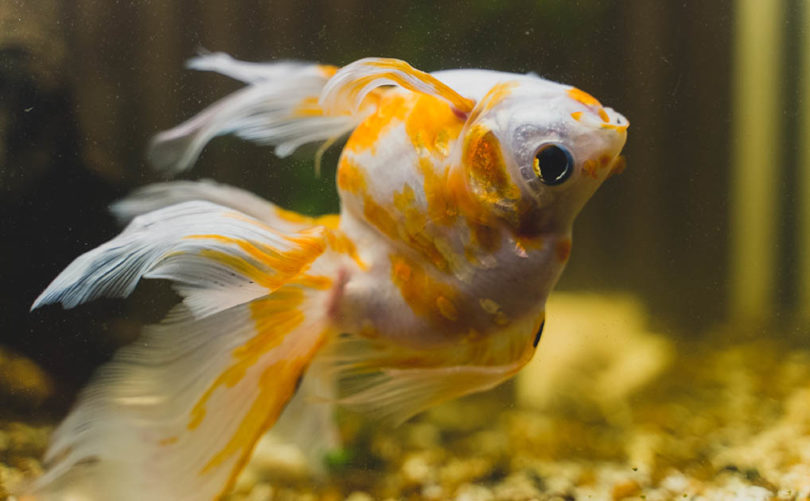
Who said goldfish have to be golden in color? The Shubunkin Goldfish, while technically a goldfish, has very little gold color on it—if any at all. But that doesn’t mean they’re not worthy of your tank.
The Shubunkin Goldfish—also commonly known as the Calico Goldfish—is a hardy swimmer that is super easy to care for. Plus, they get along with all other friendly fish. Shubunkins are great beginner fish for anyone getting into creating an aquarium.
These single-tailed goldfish are a staple of just about every single assorted fish tank out there. Let’s dive into the specifics of this fish and why they’re so popular.
Quick Facts about Shubunkin Goldfish
| Species Name: | Carassius auratus |
| Family: | Cyprinidae |
| Care Level: | Easy |
| Temperature: | 65°-72° F |
| Temperament: | Laidback and peaceful |
| Color Form: | Calico |
| Lifespan: | Up to 15 years |
| Size: | Up to 12 inches |
| Diet: | Omnivorous, Pellets and Flakes |
| Minimum Tank Size: | 75 gallons |
| Tank Set-Up: | Freshwater with planted flora |
| Compatibility: | Gets along with other peaceful fish |
Shubunkin Goldfish Overview

The Shubunkin Goldfish truly is a fish of a different color. They’re considered calico-colored, which means that they’re mottled with many different colors including black, white, red, and metallic colored scales.
It is believed that this fish was created through selective breeding around the turn of the 20th century in Japan. The Shubunkin is a direct descendant of the Prussian carp; however, the details are a bit foggy as to exactly how this happened. They also share several characteristics with carp including not having true teeth. Instead, the Shubunkin has a few rows of pharyngeal teeth in their throat.
These goldfish adapt better to colder temperatures than other similar fish, allowing them to thrive both in aquariums or outdoor ponds.
How Much Do Shubunkin Goldfish Cost?
When it comes to cost, the Shubunkin Goldfish is far from the most expensive goldfish. It’s very commonly found and can normally be found at your corner pet shop. Shubunkins are extremely affordable fish sometimes only costing a few dollars.
The most expensive part of owning these fish is purchasing the required gear to get their tank up and running. However, once set up, the Shubunkin is very low maintenance and requires little expense outside of food.
Typical Behavior & Temperament
If you’re looking for an aggressive fish, you’re not going to find one with the Shubunkin. They’re very cheerful and peaceful fish! When they’re not just lounging about the tank, you can find them darting in and out of their tank décor.
They can be relatively swift swimmers as well, unlike other goldfish. This means that they will be able to compete with other fish during feeding time. And since they can be relatively active, they make for excellent fish for children. These fish will give your little one something to joyfully watch.
Appearance & Varieties
Shubunkin Goldfish are calico-colored fish. This means they’re spotted and mottled. And they’ll take on all sorts of neat patterns and colors. However, some Shubunkins will have blue, which is the rarest color they can have. These fish are typically more expensive than other Shubunkins.
There are three main varieties of the Shubunkin Goldfish:

How to Take Care of Shubunkin Goldfish
Habitat, Tank Conditions & Setup
When it comes to keeping Shubunkin, we recommend you have at least a 75-gallon tank for adults. They’re fast growers and require plenty of room to swim around. As such, we also don’t advise keeping more than 1-2 fish in each tank. Overcrowding can be quite detrimental and dirty up a tank much faster than normal.
As far as their tank is concerned, you’ll need to get a good filtration system. They’re relatively messy fish and keeping their water clean is a must. Other than that, a low to moderate circulation is just fine.
Since the Shubunkin is so hardy, their temperature and pH levels are a broader range than other fish. Maintain their tanks between 65°-72° F and pH levels from 6.0-8.0, and they should be just fine.
They’re even easy when it comes to the substrate. Just about anything will work. We prefer using medium-sized gravel though. It helps them to sift through and find any leftovers that may have sunk to the bottom.

Are Shubunkin Goldfish Good Tank Mates?
One of the biggest issues when introducing new fish to a tank is whether or not they’ll get along with the current inhabitants. Well, you don’t have to worry too much about the Shubunkin.
They’re very likable fish—even to other fish. These are excellent swimmers to keep as part of a community or ecosystem as they aren’t aggressive. Often, you’ll find them swimming in groups with their tank mates. They’re not just social either. Shubunkins can be pretty curious little fishes. They love exploring their surroundings and dragging along a buddy to do so. There are few other fish that have such a jovial nature.
Just don’t put them in a tank with slow-swimming species. They’ll gobble up all the food and prevent your other fish from receiving proper nutrition at feeding time.
What to Feed Your Shubunkin Goldfish
When it comes to feeding time, you’ll want to make sure that your Shubunkin is getting the best nutrition. We recommend feeding them a good pellet or flake as a base source. Since they are fast enough to compete with everyone else in the tank, you don’t necessarily have to feed them sinking pellets.
We opt for TetraFin Goldfish Flakes. These flakes are packed with everything that your Shubunkin needs to maintain a healthy life without putting a strain on your wallet. Plus, their formula won’t cloud your tank, so you can enjoy watching your fish eat.
Also, you should keep some live plants within their habitat. They’ll occasionally nibble on them as well. And if you’re feeling like giving them an extra treat, your Shubunkin will appreciate brine shrimp and bloodworm as well.
Many goldfish die as a result of improper feeding, diet, and/or portion sizes – which can be easily prevented by proper education. That's why we recommend the best-selling book, The Truth About Goldfish, which covers everything about goldfish nutrition, tank maintenance, illnesses & more! Check it out on Amazon today.
Keeping Your Shubunkin Goldfish Healthy
One of the best things about Shubunkin is how healthy they are. This is one hardy goldfish. When properly cared for, these fish can live up to be 15 years old! However, like most goldfish, these fish can be quite messy. This means you’ll have to change their water relatively often.
We advise a 25% water change every other week just to keep things clean enough for them. This will help prevent parasites and bacteria from forming and attacking your fish. The most common disease that affects them is a parasite known as Goldfish Ich.
You’ll notice this parasite at a glance as it develops white spots on the fish. Fortunately, this condition is easily treatable through tank additives such as Kordon Rid-Ich Plus Disease Aquarium Treatment. It’s tough on parasites but completely safe for your fish.
Breeding
To get your Shubunkin to breed, you’ll need to simulate proper conditions. These fish breed in the warmer seasons. However, if you maintain a warmer tank, the Shubunkin won’t know any difference between breeding season and a regular lifestyle.
You’ll need to first slowly lower the temperature to a chilly 60°-62° F before you start the breeding process. Next, slowly raise the temperature by 2°-3° each day until you’re at a temperature of 72° F. Once you reach that temperature, your fish should be ready to spawn.
Males will chase the females around until finally pushing them into the plants where they will lay their eggs. The plants are necessary as they give the females a place to latch their eggs onto. Immediately after egg-laying, you need to remove the adults. If not, they’ll start eating whatever eggs they can. These eggs will hatch in around 7 days.

Are Shubunkin Goldfish Suitable For Your Aquarium?
Generally speaking, Shubunkin is good for just about any aquarium—provided you don’t put them in with an aggressive fish species. They’re cheerful, social fish that are gorgeous to look at and fun to watch.
Plus, they’re super awesome for beginning fishkeepers. They’re not too complicated to take care of and don’t cost a whole lot either.
See Also:
- 30 Types of Goldfish Varieties: Single-finned & Fancy (With Pictures)
- 10 Types of Goldfish That Can Live in Ponds (With Pictures)
Featured Image Credit: JuanCarlosPalauDiaz, Pixabay










